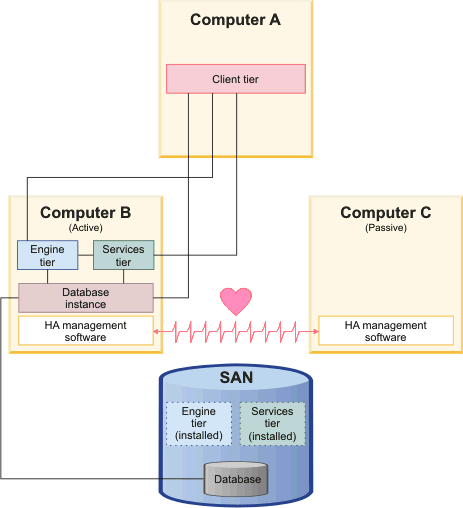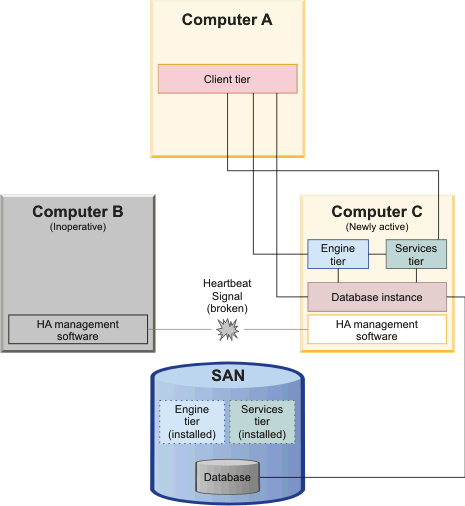Active-passive topology
To create a basic level of availability for IBM® InfoSphere® Information Server, install it on a file system that is shared by two or more computers. The computers are clustered by using high availability (HA) software.
In this topology, two computers share a storage area network (SAN). The metadata repository tier, engine tier, and services tier are all installed on the SAN. One of the computers (the active server) hosts the InfoSphere Information Server instance. The other computer (the passive server) is started, but does not run any tier software. A high availability software product such as IBM Tivoli® System Automation for Multiplatforms is installed on both the active server and the passive server. The HA software maintains a heartbeat: a periodic signal that is sent from the active server to the passive server and that indicates that the active server is operational.
The following diagram illustrates this topology. Although the diagram shows only one client tier computer, you can include multiple client tier computers.

If the active server fails, the heartbeat also fails. The HA software restarts all InfoSphere Information Server services on the passive server. This process is called a failover. The following diagram illustrates this process.

At installation time, you create a host name alias for the system. This information is associated with the active server. All client programs connect to the system by using this address or host name. If the active server fails, the information is automatically reassociated with the passive server, so client programs do not need to connect to a different address.
However, a failover is not apparent to client users. If the active server fails, all InfoSphere Information Server services are unavailable until the failover is complete and the passive server is operational. The failover process can take several minutes. Also, any jobs that were running fail and must be restarted after the passive server has taken over.
In this configuration, the HA software monitors the health only of the server hardware and operating-system-level processes. The software initiates a failover only if one of these elements fails. Other software monitors the health of individual InfoSphere Information Server processes, but does not trigger a failover if a process fails. Instead, the system administrator is notified. By using this design, a system administrator can correct the problem, instead of allowing the problem to be reproduced on the passive server.
Some other variations of this topology are possible, for example:
- Computer B hosts the services tier and the metadata repository tier. Computer C hosts the engine tier. The computers can fail over to one another. For example, if Computer B fails, Computer C also takes over the services tier and the metadata repository tier. If Computer C fails, Computer B also hosts the engine tier.
- Computer B hosts the services tier and the metadata repository tier. Computer C hosts the engine tier. Another computer (Computer D) serves as backup server for both Computer B and Computer C.
These variations are beyond the scope of this documentation.
To simplify the configuration further, you can eliminate the HA software from your implementation, and have your IT department to trigger a failover manually when necessary.
Topology dimensions and analysis
The active-passive topology is appropriate for small- to medium-sized companies with few concurrent system users. The topology provides a basic level of high availability without incurring significant additional server hardware costs. This configuration is suitable mainly for systems that run scheduled production jobs. The types of activities involved in a development environment make it more likely that a failover would cause dynamic file corruption or synchronization problems.
This topology is not scalable. You can add other passive servers if necessary. However, performance, throughput, and concurrency are not improved because at any specific time, only one instance of each tier component is running in the configuration. Among the small scale InfoSphere Information Server deployments, this topology is popular and rates high on the performance and high availability dimensions while considering the hardware, skills, and complexity dimensions.
| Consideration | Advantages and disadvantages |
|---|---|
| Level of high availability |
|
| Scalability |
|
| Security |
|
| Complexity |
|
| Maintainability | By using failover, you can take one server offline for maintenance, while the rest of the system remains operational. |
| Cost | This topology requires minimal hardware and software. |